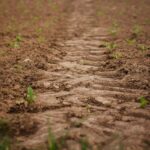Analiza prób glebowych to skuteczny sposób na zwiększenie efektywności własnych plonów.
Badania pozostałości środków ochrony roślin
Sposób wyboru próby pierwotnej, z której będzie wybrana próba reprezentatywna* .
- Próbę należy wybrać w sposób losowy, z obszaru produkcyjnego w fazie dojrzałości zbiorczej produktu, należy zachować okres karencji.
- Sposób pobierania próbek pierwotnych owoców w sadach i na plantacjach owocowych.
- Owoce pobiera się z drzew albo z krzewów wzdłuż przekątnej sadu albo plantacji, z różnych stron korony drzewa albo krzewu, a także z różnej jego wysokości i głębokości, w sposób określony w tabeli nr 1, z tym że w przypadku owoców:
- truskawki – pobiera się je z 5 sąsiadujących ze sobą krzewów;
- porzeczki lub winorośli – pobiera się grona owoców
Tabela 1. Liczba miejsc pobierania próbek pierwotnych owoców
| Drzewa owocowe | Krzewy owocowe | Truskawki, Maliny itp. | |||
| Powierzchnia uprawy (ha) | Liczba drzew | Powierzchnia uprawy (ha) | Liczba krzewów | Powierzchnia uprawy (ha) | Liczba miejsc |
| Do 0, 5 | 5 | Do 0,5 | 5-10 | Do 0,1 | 5 |
| 0,5-1 | 10 | 0,5-1 | 10-15 | 0,1-05 | 10 |
| 1-10 | 20 | 1-2 | 20 | >0,5 | 20 |
| 10-30 | 25 | >2 | 30 | ||
| >30 | Min.30 |
- Sposób pobierania próbek pierwotnych roślin okopowych i warzyw na plantacjach.
Próbki pierwotne roślin okopowych i warzyw pobiera się w liczbie miejsc określonych w tabeli nr1. w jeden z niżej podanych sposobów:
- po przekątnej powierzchni pola:

- zakosami wzdłuż powierzchni pola:

W przypadku pobierania próbek pierwotnych:
- ziemniaków oraz roślin korzeniowych- z jednego miejsca należy pobrać po kilka bulw spod sąsiadujących ze sobą krzaków ziemniaków albo kilka sąsiadujących ze sobą roślin korzeniowych i oczyścić je na sucho z gleby;
- kapusty brukselskiej – próbka pierwotna pobrana z jednego miejsca musi zawierać główki;
- pomidora, ogórka i papryki – owoce pobiera się z rożnych stron i wysokości rośliny.
Tabela 2. Liczba miejsc pobierania próbek pierwotnych warzyw i roślin okopowych
| Rośliny okopowe, warzywa | |
| Powierzchnia upraw (ha) | Liczba miejsc |
| <1 | 5-10 |
| 1-5 | 10-15 |
| 5-10 | 15-20 |
| 10-20 | 20-25 |
| >20 | 25-30 |
- Dostarczenie prób do laboratorium.
Próbę należy zabezpieczyć po pobraniu do czasu dostarczenia do laboratorium w celu uniknięcia przypadkowego zanieczyszczenia produktu. Opakowania (np. w worki z folii polietylenowej lub worki raszlowe nie używane do żadnych innych celów) zamknąć w sposób gwarantujący autentyczność prób oraz niezmienność jej składu. Na opakowaniu każdej próbki ogólnej musi znajdować się trwałe oznaczenie, umożliwiające jej identyfikację w oparciu o formularz zgłoszeniowy. Pobrane próbki należy możliwie jak najszybciej dostarczyć
- Wielkość minimalnych próbek do wysyłki.
Produkty o małych rozmiarach (np. owoce jagodowe, kapusta brukselska, groch fasola)- 1 kg Produkty o średnich rozmiarach (np. jabłka, marchew, cebula, pomidory)- 1 kg (co najmniej 10 szt.) Produkty o dużych rozmiarach (np. kapusta, ogórki, winogrona w gronach)- 2 kg (co najmniej 5 szt.) Nać pietruszki- 0,5 kg Zioła- 0,2 kg *Próba reprezentatywna – część produktu wybrana do badania metodami losowymi, przeznaczona do dostarczenia informacji na temat zawartości pestycydów w uprawianym gatunku




